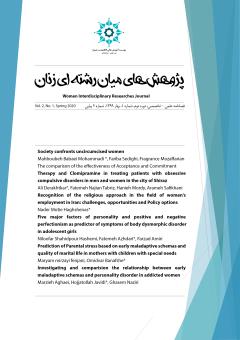-
-
List of Articles
-
Open Access Article
1 - Society confronts uncircumcised women
Mahboobeh BabaiiMohamadi Fariba Sedighi Rayeh Mozafarian -
Open Access Article
2 - The comparison of the effectiveness of Acceptance and Commitment Therapy and Clomipramine in treating patients with obsessive compulsive disorders in men and women in the city of Shiraz
Ali Derakhtkar Fatmemeh Najian Tabriz Hanie Mordadi Arame SafiKhani -
Open Access Article
3 - Recognition of the religious approach in the field of women's employment in Iran: challenges, opportunities and Policy options
Nader MotiHaghshenas -
Open Access Article
4 - Five major factors of personality and positive and negative perfectionism as predictor of symptoms of body dysmorphic disorder in adolescent girls
Niloofar Shahidpoor Fatemeh Ajhdari Farzad Amiri -
Open Access Article
5 - Prediction of Parental stress based on early maladaptive schemas and quality of marital life in mothers with children with special needs
Maryam Mirzaii Fenjani Banafshe Omidvar -
Open Access Article
6 - Investigating and comparision the relationship between early maladaptive schemas and personality disorder in addicted women
Marzieh Aghaii Hojatollah Javidi Ghasem Naziri
-
The rights to this website are owned by the Raimag Press Management System.
Copyright © 2017-2025







